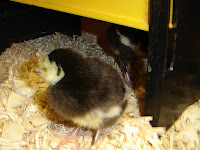All I know this far is that raising Turkeys and raising Chickens is similar but they cannot be co-mingled. The two turkey poults that we ordered arrived earlier than I anticipated! Yikes! They are not much larger than the chicken pullets at a few days of age. So that's good, because I don't have their coop put together yet. Yikes! Yikes! We do have a few weeks to put it together. I had a hard time getting any good photos.
They are the Black Spanish, which actually originated out of Mexico when Spain invaded South America. They took the black turkey back to Spain and England, then the colonists brought it back to America! Ha Ha! Any way, the Black Spanish is considered a Heritage breed. It is smaller than the turkeys eaten at holidays and they can be bred naturally (no artificial insemination needed). We will see where this goes.
I have heard that this breed of turkeys is very friendly and easy to handle. They will fly, especially the females because they only weigh about 15-18 pounds at maturity. They have been reported to fly onto roofs of houses.
These turkeys are supposed to be good forages, eating slugs and bugs, as well as grass and grass seeds. This will be perfect for our upper portion of the field.
Everything that I have read indicates that the babies are prone to die off during the first two weeks, and then again around 6 weeks. These are the vulnerable transition periods. Even the experienced turkey farmer reports about 25% die off of their chicks. I am hoping for the best!




